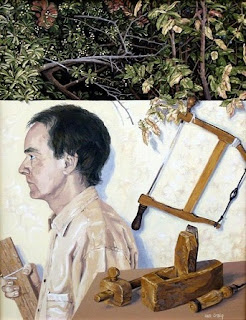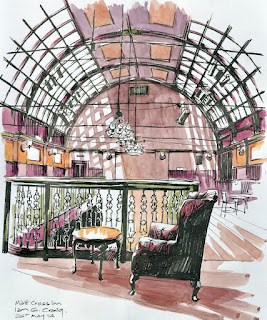During recent years depicting musicians performing live in various Nottingham venues was a recurring theme in my work. Suffice to say I didn’t paint any subject whose performance I didn’t enjoy.
Spending the early 70’s in Liverpool it was commonplace for me to see rock bands and beat poets sharing the same billing, as the preceding decade’s Mersey Beat morphed into the Liverpool Scene. It was a city where the Arts informed everyone’s way of thinking, assisted in no small measure by its Irish and West Indian links. Simultaneous to this, the steel works of Birmingham were forging sixties beat music into Heavy Metal whilst, before decade’s end, disillusioned youth in London gave vent to Punk.
By stark contrast, whenever I came home to Nottingham during the 70s, one’s social life was very much about Night Clubs. No wonder then that our city’s greatest claim to musical fame became Paper Lace of “Billy, Don’t be a Hero”. Such show bands thrived and made a good living on the chicken-in-a-basket circuit of Tiffany’s and Working Men’s Clubs across the Midlands. Punk and post-Punk bands were all happening elsewhere. We got the ones still in flared trousers with feather-cut hair.
Happily, today one can see any number of fine musicians in Nottingham, often in pubs utilizing their (usually unpaid) talents as a prop against the recession’s diminishing customer count. Listening to Nottingham bands today one is more conscious of the content of their individual record collections than any communally shared musical agenda, but that is more a comment on the city than the artist themselves. “Madchester” was never going to happen here.
Johnny Johnston Quartet at the Bell Inn:
Trad Jazz was never a favourite of mine, but the Johnny Johnston Quartet at the Bell Inn were always superb entertainment. The first band I ever thought of painting, it established at the outset how I would proceed with future similar subjects. Sketchbooks in the dark were almost impractical, but I could watch closely to memorize typical poses and expressions, and take small cell phone type snapshots, without flash, to cut up, arrange, and work from back in the studio. The background here is an impression of sound rather than an imitation of the interior.
Pictured are Johnny Johnston (left), sadly now deceased, and Brian Bocel. The band were amused and excited to see the final piece, and I enjoyed sharing it with them. The manager of the Bell Inn asked if he might put a copy on display. Fine. But I had not envisaged it would be reduced to sepia tones and pinned next to the gent’s toilet. The painting was more successfully exhibited in the Thoresby Open Exhibition of 2012.
Stuck in 2nd at the Jam Café:
The Jam Café Nottingham, functions as both licenced coffee bar, and live music venue. Pictured here are reggae band Stuck In 2nd. I remember the lighting on that occasion was particularly dark, so more than ever I relied on a liberal use of shadows to disguise my lack of information, and think some of the final painting a little too static. But I was happy with the way I captured the movement of the conga player on the left, his entire body swaying and playing the instrument. If you can play an instrument yourself (I can manage about four chords), it helps when trying to convey rhythm pictorially, or having to make up small details in the final piece.
Will Jeffery at the Malt Cross Inn:
As readers will know from previous posts, the Malt Cross Inn was a music hall in eras gone by, and the small stage is still used today to present live entertainers. What obviously caught my attention in this scene was the very dramatic lighting from the spotlights, making pools of light on the stage and casting large shadows on the wall behind. An opportunity to paint an upright bass in such a setting was not to be missed. Never successfully exhibited publicly, this one remains my personal favourite.
Jonathan Beckett at the Guitar Bar, Hotel Deux:
When Jonathan Becket performed a retrospective of his songs at the Guitar Bar I was especially taken by one called “The Midlands”, a recurring theme in my own work. Once again I returned to my studio with some very hazy snapshots from which I could produce a “likeness” of the two musicians involved, working from blow ups on the computer screen as if they were seated before me. But this time I created a background based on images associated with the Midlands. One can see references to miners, Sherwood Forest, and factory building skylines. The painting was successfully exhibited in the Patchings Open Exhibition of 2012.
Rosie Abbott, singer songwriter:
Between 2006 and 2010 I made a series of music promos for
Rosie Abbott. This portrait came from an image made during one of those video shoots. Rather than depict a public performance, I wanted to convey more of the creative spirit of the songwriter. The painting was successfully exhibited in the Patchings Open Exhibition of 2011.
Thee Eviltones at The Maze:
My last musician painting to date. The Maze is an especially dark venue, and certainly one of Nottingham’s most popular. Once again it was a matter of crawling about below audience eye level, not distracting from their entertainment with an intrusive flash, taking small snapshots. Back in the studio I chose and arranged what seemed like a typical “pose” for each band member. I knew I wanted a dynamic setting for such a high energy band. The solution was inspired quite simply by the band’s striped t-shirts. If it was such an important motif to them that they each wore one, then it was important enough to incorporate in the painting.
All text, pros, poetry & artwork, copyright Ian Gordon Craig.




















































